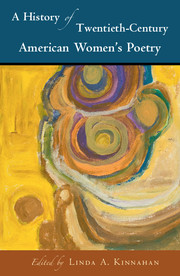Book contents
- Frontmatter
- Contents
- List of figures
- List of contributors
- Preface
- Acknowledgments
- PART I MAPPINGS AND CHRONOLOGIES
- PART II ETHNICITY, RACE, AND IDENTITY
- PART III MATERIAL FORMATIONS
- PART IV LINEAGES, TIES, AND CONNECTIONS
- 15 Token Women, Male Movements, and Literary History's Feminist Shadow
- 16 Lineages and Legacies: Real and Imagined
- 17 Crossing Geographies, Crossing Languages
- 18 Women's “spiritualities”
- PART V FORM, LANGUAGE, AND TEXT
- PART VI CODA
- Bibliography
- Index
15 - Token Women, Male Movements, and Literary History's Feminist Shadow
from PART IV - LINEAGES, TIES, AND CONNECTIONS
Published online by Cambridge University Press: 05 June 2016
- Frontmatter
- Contents
- List of figures
- List of contributors
- Preface
- Acknowledgments
- PART I MAPPINGS AND CHRONOLOGIES
- PART II ETHNICITY, RACE, AND IDENTITY
- PART III MATERIAL FORMATIONS
- PART IV LINEAGES, TIES, AND CONNECTIONS
- 15 Token Women, Male Movements, and Literary History's Feminist Shadow
- 16 Lineages and Legacies: Real and Imagined
- 17 Crossing Geographies, Crossing Languages
- 18 Women's “spiritualities”
- PART V FORM, LANGUAGE, AND TEXT
- PART VI CODA
- Bibliography
- Index
Summary
Metanarrative gets motivated, in part, by somewhat belligerent, somewhat embarrassed, somewhat mournful and apologetic response to situations that involve female occlusion.
Rachel Blau DuPlessis, “Manifests”[C]ertain literary movements are ways of inviting little wars and little frames of wars.
Gabriel Gudding, “On Hipness and Kindness as They Relate to Cultural Production”The token woman poet is a peculiar feature of American literature familiar to any student of its poetry. Emily Dickinson, for decades the one nineteenth-century American woman poet exceptional enough to be considered literary, is perhaps the most famous. In the century that follows hers, the token woman poet multiplies as literary categories and subgenres complicate and divide periodization. The meaning and forms of women's tokenism vary as well. Authored by the single woman poet recognized in a century, Dickinson's radical formal innovations stand as counterpoint to and evidence of a widespread sameness among too many “poetesses” whose writing answered to the predictable tastes of their readership. Dickinson, often hyper-feminized in twentieth-century criticism, stands apart from other nineteenth-century poetesses because she converted her womanly experiences into writing that was different from and better than theirs.
With the advent of modernism, women's tokenism tends to operate in direct comparison to male poets, although the meaning of that tokenism differs from one woman poet to another. For example, H.D., like Dickinson, retains an intensely feminine identity as the original practitioner of Imagism, but her poetry becomes the intuitive-emotional substance Ezra Pound articulates in poetic theories mobilizing Imagism and Vorticism. Mina Loy and Marianne Moore, quite differently, become tokenized through their ability to write without emotion or “exaggerated ‘nationalism.’” This ability almost completely concealed the fact that they were women and permitted (Pound gave that permission) their rightful inclusion in a 1917 anthology of modern poetry. In the 1920s, Laura Riding contributed to poetry workshops with the Fugitive poets in what became “close reading” practices developed by the New Criticism, yet Riding is only grudgingly mentioned in accounts of the Fugitive-Agrarian school.
- Type
- Chapter
- Information
- A History of Twentieth-Century American Women's Poetry , pp. 241 - 257Publisher: Cambridge University PressPrint publication year: 2016
- 1
- Cited by



